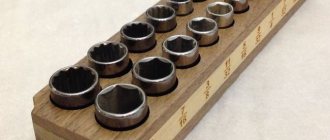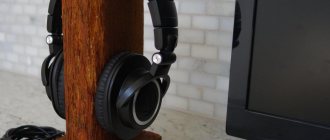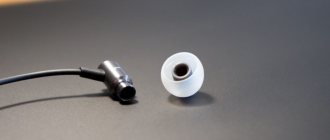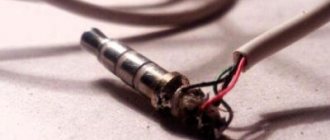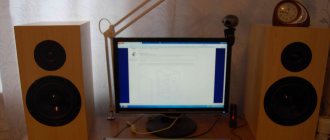We have already told you how to correctly read the characteristics of headphones. We hope that you figured it out and took note of this information. Today we’ll talk about what types of headphones there are, that is, we classify them according to various criteria.
According to acoustic design
Based on their acoustic design or design, all headphones can be divided into three types: closed, open and semi-closed (half-open).
- In closed-type
, the driver emits a sound wave only into the ear; they are sealed from the outside. Closed-back headphones are great for immersing yourself in sound. That is, people nearby do not hear the music played in the headphones, but the one who is wearing the headphones does not hear external sounds. This type of sound insulation is called passive.
Advantages:
- tight fit and excellent sound insulation;
- lack of audibility for others;
- juicy bass;
- detailed sound even at low volumes.
Flaws:
- the sound is not realistic enough compared to open headphones;
- unsafe for listening on a busy street;
- Listening for a long time may give you a headache.
- In open-back headphones,
the driver emits sound in all directions. In them, the listener is not isolated from the noise, just as those around him are not isolated from his music. Compared to closed-back headphones, open-back headphones will give you better sound quality because the sound is not distorted by reflections inside the sealed housing.
Advantages:
- the most realistic, uncolored and clear sound;
- safety, which consists in the ability to hear warning signals, for example, from a car;
- comfortable ear pads when your ears don’t sweat and your head doesn’t hurt.
Flaws:
- low noise insulation, which does not allow you to fully immerse yourself in listening;
- irritation of others with sound from headphones;
- The bass sounds worse than with closed headphones.
- Obviously, half-closed or half-open
(these are the same thing) headphones have partial noise isolation. These headphones have a closed cup with holes. Often, such headphones are purchased for professional activities, as they provide some sound insulation and realistic sound with the possibility of long-term use. However, you won’t be able to completely immerse yourself in the music, since they still let in some external noise.
Which headphones should you choose? The answer to this question depends on the tasks at hand and the acoustic environment in which the headphones will be used. If you plan to listen to music with headphones in noisy places (transport, studio while recording vocals or instruments), then it is better to choose closed headphones. When the sound from headphones does not bother anyone (for example, at home or when you work alone), but external noise can warn, for example, of danger (on the street), you can use open headphones.
Contents of delivery
The headphones are delivered in a black box made of carbon fiber, where, surprisingly, you won’t find all these “Hi-res”, “High-definition” and so on stickers that noticeably make the headphones cheaper out of the box. Here you can see only a picture of the model itself and its name, nothing more. Such a design solution, not even for headphones, but just for a box, is a good predisposition to oneself and sets the mood for the fact that there is a quality thing inside.
In the box itself you can find a high-quality double 3.5 mm cable, an adapter from 3.5 to 6.3 mm and a storage pouch. This very bag disappointed me a little, of course I would have liked at least some kind of protective case, but even for that I’m grateful, since the same Sennheiser and Beyerdynamic in this price range do not offer you either a case or a cover.
By design
Based on design, fit, and form factor, there are three types of headphones: full-size, on-ear, in-ear, and in-ear.
- Over-ear headphones
are also called surround, monitor or arc headphones. They have a headband and large ear pads that completely cover the ears without pressing them to the head. It's rare, but you can still find headphones without ear pads (for example, AKG K1000). Over-ear headphones are easy to use as they have a comfortable fit, but they are bulky and not suitable for listening with a headgear. Over-ear headphones are versatile. Closed monitor headphones do not have the highest noise insulation; their sensitivity is insufficient for portable sound sources, so they require amplification. In this regard, monitor headphones are used mainly indoors, for example, in recording studios.
- Over-ear headphones
are more compact, making them more portable. The ear pads are pressed tightly against the auricle, the speaker is located closer to the ear, so the sensitivity of on-ear headphones is usually higher than that of full-size ones. Over-ear headphones are ideal for short periods of use due to the pressure of the ear pads on the ears.
- In-ear (vacuum) headphones
are inserted directly into the ear canal, creating something like a vacuum there, and are held there thanks to silicone ear pads. Due to the proximity of the emitter to the ear, these headphones allow you to listen to music quietly while maintaining sound clarity. Such headphones are often used on the street, in transport, during sports, etc.
Advantages:
- compactness,
- passive noise isolation (closed headphones),
- versatility,
- high sensitivity.
Disadvantage: Listening to music at high volumes can damage your hearing.
- In-ear headphones (pills)
are headphones that are placed in the auricle rather than inserted into the ear canal. Most often they are open or semi-open, less often closed, but they still allow external noise to pass through due to their loose fit to the ear canal. The advantages include compactness and low price (with the exception of AirPods). Earbuds are convenient to use outdoors, but in transport the sound will disturb other passengers if the headphones are open.
Ribbon Headphone Source
Ribbon emitters have their own characteristics when used. The most important is the electrical resistance of the order of hundredths of an ohm. This means that you cannot directly connect them to conventional sources. Or rather, it is possible, but no one guarantees whether the source will survive this connection or not. As a rule, amplifiers have short circuit protection in the form of a resistor at the output. If you're lucky and the amp doesn't burn out, the sound will still be very quiet. All headphone outputs in the vast majority of devices have the ability to output a current of about 50 mA, in special cases up to 100 mA. This is not enough.
The electrical load and signal source must be matched so that their input and output impedances are as close as possible. Thus, a signal source with minimal internal resistance is needed. This can be achieved in two ways.
Use a transformer. Of course, such a transformer has special requirements. Ideally, its core should be made of special iron with minimal hysteresis, but in extreme cases, ordinary iron from household voltage transformers will do. One winding should have a resistance of the order of the output resistance of the amplifier, and the second winding, which in this case is usually made of Litz wire, of several turns with a resistance of a couple of decimal places. However, it is necessary that the second winding be connected to the tape as close as possible to minimize resistance, since even a meter of ordinary cable will have a resistance two orders of magnitude higher than the resistance of the tape and mismatch will again arise. Thus, the transformer must be located directly next to the tape, which is somewhat inconvenient due to the large weight of headphones in this design. By the way, ribbon headphones are ideal for tube amplifiers, which have output transformers. True, in such a scenario you need to use a fairly thick wire.
The second option is to create a specialized amplifier. Strictly speaking, you can take a ready-made powerful amplifier (at least 5-10 W), just use an adapter with ballast resistance. This resistor matches (with heat generation) the output of the amplifier and the input of the headphones, so the amplifier operates in its normal mode, and the headphones receive the highest quality signal. It is worth mentioning that it is possible to assemble an amplifier in such a way that it may not require such a resistor, but this task is already for professional electronics engineers, of which I do not consider myself. In any case, the efficiency of such a solution will be very low. But it's worth it, at least for the comfort.
I stick to the second option with a special amplifier. Why install a transformer if you can not install it? In addition, even for ordinary plugs I use a separate amplifier; I always have room for another one. Homemade amplifier using a multi-loop circuit from Chinese non-original TDA2030A and OPA2134. This is evidenced by the fact that the quiescent current of an amplifier with three (!) TDA2030A is 70 mA, judging by the LBP readings, while the norm according to the datasheet for one TDA2030A is 80 mA. Still, I’m very interested in what they sold me under the guise of these op-amps. By adding a 15 Ohm ballast resistance, I managed to get the desired output current and obtain the desired operating mode of the op-amp, which for my emitters is about 0.45 A per channel at maximum volume. At this level it is impossible to listen to them on your head, but using them as small speakers is quite possible. And as quiet as you like, it plays well too.
By emitter type
There are five types of drivers in headphones: dynamic, armature, planar, electrostatic and hybrid.
- Dynamic headphones
are the most popular, their technologies are constantly being improved and even at a low cost of headphones they produce high-quality sound. The dynamic driver in headphones works on the same principle as the speaker of an acoustic speaker. A magnetic coil is connected to the cone diffuser. When an electric current appears in the coil, a magnetic field appears around it, which interacts with the diffuser. The diffuser vibrates when the field (alternating current) changes, generating sound frequencies.
- Armature headphones
are rapidly gaining popularity due to the fact that, despite their compact size, they provide highly detailed sound. These headphones are often used for monitoring sound at live concerts. Due to the compactness of the reinforcement emitters, several of them can be inserted into one earphone, and each of them will be responsible for a certain frequency interval: HF, LF and mid.
- Electrostatic headphones
are high-end, elite headphones. Sound is generated when an ultra-thin membrane oscillates in a magnetic field between two stator arrays. This device is very expensive to manufacture; headphones require a powerful amplifier, but models with electrostats can boast the most accurate sound reproduction and fast response, which is highly valued by professionals and music lovers who are willing to pay a high price for the opportunity to enjoy high-quality sound.
- Planar headphones
include two subtypes: isodynamic and orthodynamic, which do not differ much in technology, which the average listener cannot distinguish by ear. Isodynamic headphones are similar in principle to electrostatic ones: there, too, a membrane with a flat coil applied to it oscillates between the stators, but the signal is supplied to the membrane itself, and not to the stators. Isodynamic headphones have the same fast response as electrostatic ones, but they lose in sound detail.
- Hybrid headphones
are a comprehensive solution when different types of emitters are combined in one housing. Typically, hybrid headphones have the form of in-ear headphones, which have built-in dynamic and reinforcement emitters.
Razer Kraken Tournament Edition
- Microphone: retractable unidirectional.
- Connection: wired.
- Frequency range: 12–28,000 Hz.
- Resistance: 32 ohms.
- Sensitivity: 109 dB.
The model with support for THX Spatial Audio 3D audio technology uses 50mm speakers to broadcast a signal over a wide range. During the game, you can adjust the volume, balance of game effects and audio chat, activate 7.1 surround sound mode, and also control the microphone. The Razer Kraken Tournament Edition features large, soft gel-filled ear cushions covered in synthetic leather and fabric.
Price: 8,290 rubles.
Buy
By purpose
Depending on where and for what purposes you will use headphones, you can also distinguish several types.
- Stationary headphones
, which are commonly used at home. What are they? Most often they are full-size, open (less often closed) and high-impedance, if there is an amplifier.
- Monitor headphones
, used for work in the studio: full-size, high-impedance, for work on stage: reinforced in-channel.
- Gaming headphones
for gamers look like this: full-size with a microphone. They are not suitable for listening to music, since their purpose is to sit comfortably on the ears for a long time and have “raised” bass (for explosions, gunshots, etc.).
- Portable headphones
, which are used to listen to music from a phone, player, etc. They are compact, low-impedance with high sensitivity. The form factor can be any, as they say, according to taste and color...
- A headset
is a compact headphone with a microphone that can even have one “ear” and is used for hands-free conversations.
- Sports headphones
are most often in-ear, but recently they have been actively using on-ear headphones, namely AirPods, and you can also find on-ear headphones among them. Requirements for sports headphones: fit securely in (on) the ears when running without creating discomfort, have additional protection from water (headphones for swimming) and dust, be wireless. Sound quality is usually not given enough attention here.
All characteristics of headphones, even those that seem to relate only to design, affect the sound they produce. Select several models that meet your needs and tasks that you want to solve with headphones, then compare the selected models with each other through live listening. Only your ears will tell you the right choice. Happy shopping that won't disappoint you!
Homemade magnetoplanar headphones
The distance between the tracks is about 0.3 mm.
To refute or confirm this hypothesis, I started creating my own magnetoplanar drivers and housings for it. Now, from the height of experience, it has become clear that the amount of effort is disproportionate to the result. I managed to develop a technology with fairly good repeatability and high accuracy, almost without phase and other distortions, but I did not break out of the limitations of the technology and still did not get the desired result in sound. In addition, after listening to factory samples from Audeze, confidence in the small sense of continuing to work in planar technology was completely strengthened. It became clear that the sensations of live music would be difficult to achieve on such rails. From the height of experience, I can now put forward a hypothesis as to why this happened with planar technology. But more on that later. Homemade magnetic planars turned out no better and no worse than other similar headphones. Even the original form factor didn't help. What's the end result? Go up a level and see where erroneous conclusions might appear there. The hypothesis about the importance of phase distortions was not confirmed. This project was abandoned.
As it turns out, this approach has little prospects.
It seemed most logical to me to turn to the “source” of the problem - sound engineers. How is content created, how is it stored and reproduced? I’ll say right away that I don’t take into account special binaural recordings made in other conditions, but we still need to try to find such ones.

